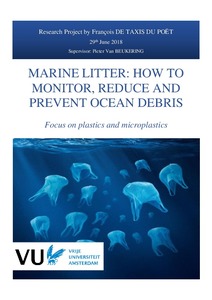Marine litter: how to monitor, reduce and prevent ocean debris. Focus on plastics and microplastics.

View/
Average rating
votes
Date
2018Author
De Taxis Du Poët, François
Status
PublishedPages
52pp.
Metadata
Show full item recordAbstract
We live in the age of plastics. They are ubiquitous in our daily life and in many industrial applications. They play a major role in our economy. Their production continuously increases. However, plastics are not well managed and found their way to the oceans, leading to far-reaching environmental, health, social and economic impacts. Hence the challenge is to maintain the economic and societal benefits brought by plastics but avoiding that they end up in the environment.
Although there are knowledge gaps, the key elements are clear: 80% of marine litter is plastics. 94% is on the sea floor, only 1% is floating. Half of the marine litter are single use plastics. Marine plastic litter is found in high concentration on beaches, two orders of magnitude higher than anywhere else. The key points of intervention are beaches, wastewater treatment plants, and rivers. Floating plastics might therefore be less important than it can appear in the media.
Many efforts are being implemented at all.....
Resource URL
https://www.claim-h2020project.eu/publications/Publisher
Vrie UniversiteitAmsterdam, Netherlands
Document Language
enSustainable Development Goals (SDG)
14.1Best Practice Type
Manual (incl. handbook, guide, cookbook etc)Citation
De Taxis Du Poët, F. (2018) Marine litter: How to monitor, reduce and prevent ocean debris. Focus on plastics and microplastics. Amsterdam, Netherlands, Vrie Universiteit, 52pp. DOI: http://dx.doi.org/10.25607/OBP-871Collections
 Repository of community practices in Ocean Research, Applications and Data/Information Management
Repository of community practices in Ocean Research, Applications and Data/Information Management